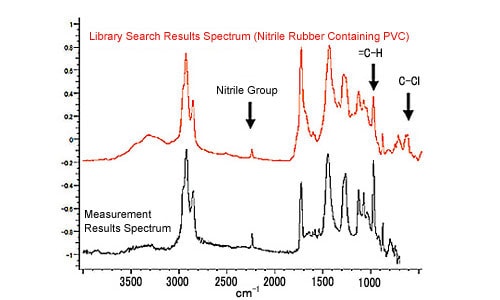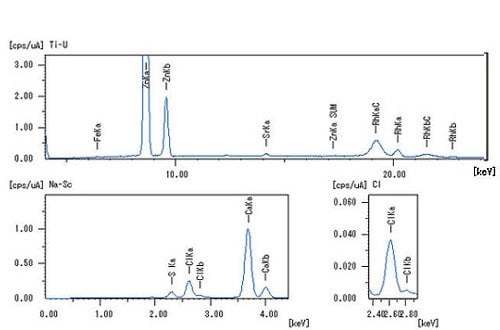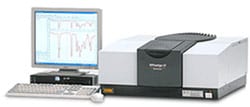Qualitative Analysis of Rubber (FTIR and EDX)
One method of qualifying rubber is measuring the attenuated total reflectance (ATR) using a fast and simple infrared spectrophotometer (FTIR). Using the ATR method allows obtaining an infrared spectrum easily by pressing the rubber tightly against a prism surface, which allows qualitative analysis of the rubber. In addition, Energy Dispersive X-ray (EDX) fluorescence spectrometers can be used to easily, quickly, and non-destructively analyze the constituent elements.
In this example, FTIR and EDX systems are used to qualify a rubber diaphragm sample.
Analysis Using the FTIR – ATR Method
The sample was measured using the Ge prism on the PIKE MIRacle single-reflection ATR accessory. Baseline correction and a spectrum search were performed for the spectrum obtained from measurements. The spectra below are for nitrile rubber containing PVC (polyvinyl chloride), where the lower spectrum is from measurement results and the upper spectrum is from the database search.
(The presence of nitrile rubber can be confirmed from the peaks for the nitrile group near 2200 cm-1 and the out-of-plane bending vibration from the =C-H bonds near 966 cm-1, whereas PVC can be confirmed from the peak near 600 cm-1, due to C-Cl stretching vibrations. However, since the spectrum from measurement results does not show measurements below 700 cm-1, due to absorption by the Ge prism itself, it does not allow confirming the C-Cl peak.)

FTIR Data Measurement Peaks (After Correction) and Library Search Spectrum

EDX Qualification Results
Analysis Using EDX
The figures above show the results from using EDX to qualify the same sample. The elemental measurement range is from Na to U. These results indicate that the primary components are S, Cl, Ca, and Zn. The Cl detected by EDX is presumed to be the Cl contained in the PVC, based on FTIR search results. Also, the Ca is presumed to be contained as calcium carbonate. This judgment is based on the fact that peaks (near 1430 cm-1 and 880 cm-1) characteristic of calcium carbonate in infrared spectra were also confirmed in the FTIR measurement results.
Based on the above results, the rubber diaphragm is presumed to contain nitrile rubber, polyvinyl chloride, and also calcium carbonate.
Fourier Transform Infrared Spectrophotometer

An FTIR spectrophotometer is mainly used to estimate the structure of organic compounds.
This instrument shines infrared light onto the molecules, which absorb infrared radiation equivalent to the interatomic vibrational energy of the atoms comprising the molecules. It then estimates the structure and quantifies the compound by investigating this IR absorbance.
Energy Dispersive X-Ray Fluorescence Spectrometer (EDX)

The instrument directly irradiates a sample with X-rays and measures the energy and intensity of the secondary fluorescent X-rays that are generated. This permits non-destructive characterization of the constituent elements of the sample (qualification) and measurement of their concentrations (quantification). Ideal for identification of elements in solid, powder, and liquid samples, this method is extremely easy and rapid, as no chemical pretreatment is required and multiple elements are analyzed simultaneously.


